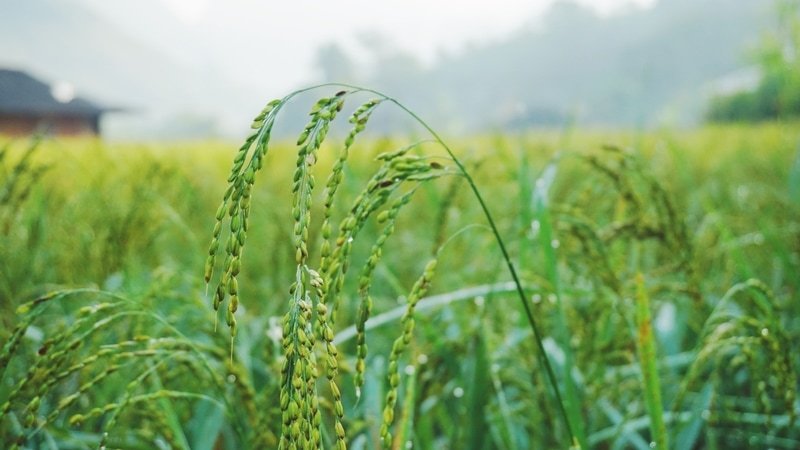Reducing emissions, one rice field at a time
WINZ’s Rethinking Rice series speaks to experts innovating water solutions to reduce emissions from rice.
Rice is responsible for 10% of global methane emissions and represents an enormous opportunity to mitigate climate change in the agricultural sector. SRI-2030 wants to change this through promotion of the System of Rice Intensification (SRI) - a guiding set of principles, proven to boost yields and reduce emissions that requires farmers to rethink traditional practices.
In 2023, SRI-2030 launched the Sustainable Rice NDC Alliance to drive countries to make commitments to reduce emissions from rice production. SRI-2030’s Programme Director, Francesco Carnevale Zampaolo, spoke to WINZ about how SRI can combat emissions, and what the next steps needed are.
How does sustainable rice intensification work?
The System of Rice Intensification (SRI) is a management strategy that boosts rice production by utilising reduced plant density, early and careful plant establishment, non-flooded soils, and an increased reliance on organic amendments (without necessarily being a fully organic approach). These practices combine to increase soil and plant health to increase yield and decrease the climate impact. It's not a one-size-fits-all approach for farmers to simply apply; rather, it is a guiding set of principles that requires farmers to rethink traditional practices and tailor them to optimize rice plant growth.
What benefits does SRI provide for farmers?
When introduced as an alternative to poor management practices, SRI typically boosts grain yield by 20-50%, with some studies indicating even greater increases ranging from 50% to over 100%. SRI not only boosts farmers' net income from rice production due to increased yields but also reduces input costs, particularly for seeds, energy, and synthetic chemical fertilisers and pesticides. This leads to economic gains ranging from 40% to 70% and even exceeding 150%. As energy and agrichemical costs rise, and water becomes scarcer in many rice-producing areas, the economic justification for adopting SRI becomes even stronger.
How does SRI contribute to climate mitigation?
In irrigated areas, the primary water management practice for SRI is alternate wetting and drying (AWD). This practice leads to healthier plants but also significantly reduces methane emissions by ensuring the soil is not continuously flooded. By reducing the anaerobic conditions of the soil, which support the proliferation of methanogens, the SRI approach decreases methane emissions.
The magnitude of any reduction of methane emissions is highly context-dependent due to variations in soil and environmental conditions. When considering the benefits of AWD with other principles of SRI such as reduced input of nitrogen fertilizer and active soil aeration, SRI leads to an average reduction of CO2-equivalent emissions per kg of rice produced of 48%. In addition to this, there is an increasing body of evidence which shows that SRI also increases soil carbon sequestration.
What is the current scale of application and how could it be expanded across the rice production sector?
Currently, it is estimated that SRI methods are practiced on 9 million hectares globally, which is a small fraction of the ~160 million hectares of rice cultivation worldwide. Unlike conventional approaches to agricultural development, SRI is knowledge-intensive rather than input-intensive. Therefore, the key factor for scaling up SRI methods is establishing a robust network of extension workers and farmer field schools (FFS). These entities engage smallholder farmers, who account for about 90% of global rice production, and allow farmers to make use of context-specific knowledge.
Furthermore, the dissemination of SRI methods relies on the availability of suitable mechanization for various field activities such as land preparation, transplantation of young seedlings, or direct seeding using SRI spacing, as well as weeding. Additionally, since the effective implementation of SRI depends on the ability to control water in the field, infrastructure is necessary in both rainfed and irrigated areas. This infrastructure enables farmers to independently manage irrigation and drainage, allowing them to determine when to irrigate and when to dry their fields.
“Countries are motivated to commit to reducing emissions from rice production when they have access to approaches that do not compromise yield.”
In 2023, SRI-2030 launched the Sustainable Rice NDC Alliance. What drives countries to make commitments to reduce emissions from rice production and what more can be done to catalyse success in reaching those commitments?
Countries are motivated to commit to reducing emissions from rice production when they have access to approaches that do not compromise yield. This is especially crucial because rice plays a vital role in national food security and is primarily consumed domestically, unlike other major crops such as maize, wheat, and soy. Therefore, ensuring rice food security is an essential component of these commitments.
Additionally, countries are more inclined to make rice-related commitments when they have access to appropriate Monitoring, Reporting, and Verification (MRV) systems to track their progress effectively.
Although some progress towards these commitments can be made by redirecting existing funding, many countries face barriers in meeting these commitments due to the limited resources and capacity. To overcome these barriers, it is essential to allocate climate finance towards the development of rice sectors. Due to its food security benefits, development investments can also be used to fund implementation of SRI. Ensuring alignment between development and climate investments in rice production will help countries to fulfill their climate commitments while also enhancing food security and sustainability in the rice sector.
“The future of low-emission rice production must prioritize solutions that preserve the fragile social and economic balance of rural communities.”
What do you see as keys for future low-emission rice production?
Given that the majority of rice farmers are smallholders, the future of low-emission rice production must prioritize solutions that preserve the fragile social and economic balance of rural communities. Small-scale farmers must directly benefit from the adoption of agroecological practices, allowing them to mitigate environmental impacts while enhancing yields, increasing income, and bolstering resilience to climate change.
To realize this vision, governments should establish policy and economic frameworks incentivizing private sector investment in farmer-friendly technologies that promote the adoption of regenerative agricultural practices. Additionally, financing institutions and development agencies should support governments by providing adequate resources and assistance in formulating climate-friendly approaches.
About SRI-2030
SRI-2030 is an initiative to rapidly expand the use of eco-friendly agricultural practices around the world, particularly the System of Rice Intensification (SRI) and related methods that reduce greenhouse gas emissions and enhance carbon sequestration to combat global warming and climate change while meeting human needs more efficiently and abundantly.
SRI-2030 builds on the work of millions of farmers in over 60 countries and more than two decades of research, outreach and extension by hundreds of scientists, international and local NGOs, government personnel, private sector actors, and many other advocates.
Francesco Carnevale Zampaolo
Francesco is Program Director for the developing practice of SRI, including the integration with Conservation Agriculture. He also leads for South Asia, MENA and our relationship with agricultural organisations including the FAO.



